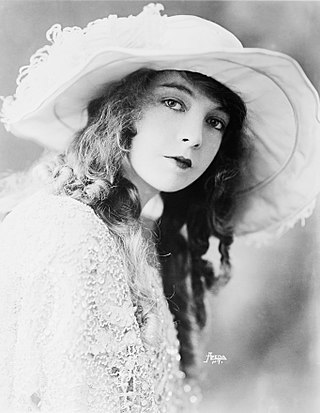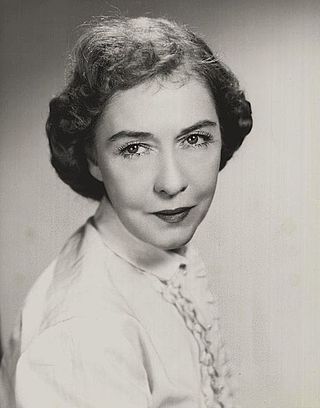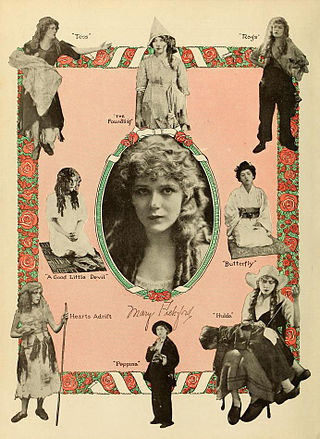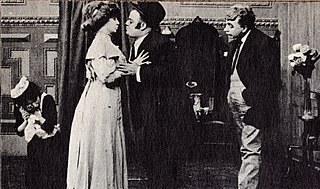
David Wark Griffith was an American film director. Considered one of the most influential figures in the history of the motion picture, he pioneered many aspects of film editing and expanded the art of the narrative film.

Gladys Marie Smith, known professionally as Mary Pickford, was a Canadian stage and screen actress and producer with a career that spanned five decades. A pioneer in the US film industry, she co-founded Pickford–Fairbanks Studios and United Artists, and was one of the 36 founders of the Academy of Motion Picture Arts and Sciences. Pickford is considered to be one of the most recognisable women in history.

Lillian Diana Gish was an American actress, director, and screenwriter. Her film-acting career spanned 75 years, from 1912, in silent film shorts, to 1987. Gish was called the "First Lady of American Cinema", and is credited with pioneering fundamental film performance techniques. In 1999, the American Film Institute ranked Gish as the 17th greatest female movie star of classic Hollywood cinema.

Dorothy Elizabeth Gish was an American actress of the screen and stage, as well as a director and writer. Dorothy and her older sister Lillian Gish were major movie stars of the silent era. Dorothy also had great success on the stage, and was inducted into the American Theater Hall of Fame. Dorothy Gish was noted as a fine comedian, and many of her films were comedies.

Biograph Studios was an early film studio and laboratory complex, built in 1912 by the Biograph Company at 807 East 175th Street, in The Bronx, New York City, New York.

Marion Leonard was an American stage actress who became one of the first motion picture celebrities in the early years of the silent film era.

Judith of Bethulia (1914) is an American film starring Blanche Sweet and Henry B. Walthall, and produced and directed by D. W. Griffith, based on the play "Judith and the Holofernes" (1896) by Thomas Bailey Aldrich, which itself was an adaptation of the Book of Judith. The film was the first feature-length film made by pioneering film company Biograph, although the second that Biograph released.

The New York Hat is a silent short film which was released in 1912, directed by D. W. Griffith from a screenplay by Anita Loos, and starring Mary Pickford, Lionel Barrymore, and Lillian Gish.

An Unseen Enemy is a 1912 Biograph Company short silent film directed by D. W. Griffith, and was the first film to be made starring the actresses Lillian Gish and Dorothy Gish. A critic of the time stated that "the Gish sisters gave charming performances in this one-reel film". The film was shot in Fort Lee, New Jersey where early film studios in America's first motion picture industry were based at the beginning of the 20th century. Consistent with practice at that time, the actors in the cast and their roles are not listed in the film..

The Sealed Room is an eleven-minute film released in September 1909. Produced by the Biograph Company and directed by D. W. Griffith, the drama's cast includes Arthur V. Johnson, Marion Leonard, Henry B. Walthall, Mary Pickford, and Mack Sennett. It was distributed to theaters on a split-reel with another film, the three-minute comedy short The Little Darling.

Mary Pickford (1892–1979) was a Canadian-American motion picture actress, producer, and writer. During the silent film era she became one of the first great celebrities of the cinema and a popular icon known to the public as "America's Sweetheart".

Ramona is a 1910 American short drama film directed by D. W. Griffith, based on Helen Hunt Jackson's 1884 novel Ramona. Through a love story, the early silent short explores racial injustice to Native Americans and stars Mary Pickford and Henry B. Walthall. A copy of the print survives in the Library of Congress film archive. The film was remade in 1928 with Dolores del Río and 1936 with Loretta Young.

So Near, Yet So Far is a 1912 American silent drama film directed by D. W. Griffith. Prints of the film survive in the Museum of Modern Art film archive.

The Unwelcome Guest is a 1913 American silent drama film directed by D. W. Griffith.

My Baby is a 1912 American short comedy film directed by D. W. Griffith and Frank Powell. Prints of the film exist in the film archives of the Museum of Modern Art and the Library of Congress.

Dorothy West was an American stage and film actress and radio performer.

The Italian Barber is a 1911 short silent drama film directed by D. W. Griffith, starring Joseph Graybill and featuring Mary Pickford. The film, by the Biograph Company, was shot in Fort Lee, New Jersey when many early film studios in America's first motion picture industry were based there at the beginning of the 20th century.

Mrs. Jones Entertains is a 1909 American silent short comedy film directed by D. W. Griffith. The Internet Movie Database lists Mary Pickford as appearing in this short. However, Pickford did not begin with Biograph until the end of April 1909.

The Gibson Goddess is a 1909 short comedy film directed by D. W. Griffith. It stars Marion Leonard.
As It Is In Life is a 1910 silent short film directed by D. W. Griffith and produced and distributed by the Biograph Company. Mary Pickford appears in the film.




















